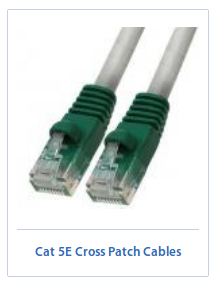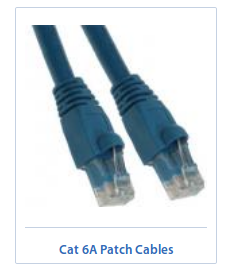CAT 5E Vs CAT 6A: Understanding the Major Differences
Transmission speed, connection, distance and costs. These are some of the factors you need to consider when it comes to buying cables for your ethernet network. “Should I use category 5E or 6A for wiring my ethernet network?” People often ask this question. This is majorly because all these cables have different names, standards and configurations.
Today, we will focus on CAT5E and CAT6A Cables and understand the major differences between them. Thereafter, you might be able to make the right choice. Let’s understand about CAT5E Cables first.
CAT 5E Cables

CAT 5E emerged as the first to hit the potential of 1 gigabit network. It is now 15 years old. If you aren’t willing to spend much and do not mind using old cables, CAT 5E can be a good choice. CAT 5E Cables are an enhanced version of CAT 5. You might find them at the lowest prices but sometimes, their transmission speed is low.
This ethernet cable allows the data transfer speed of 1 Gigabit per second at 100 MHz up to 328 feet. When you use this cable, there are less chances of transmission errors and interruptions. The reason? Well, there is lesser crosstalk amongst the wires in the cable. Although, it shows lesser upgradation adaptability for future applications, it renders a good output if you want to apply it in today’s applications.
CAT 6A Cables

With price, comes the quality – Do you have this mindset? If yes, you must go for – CAT 6A Cable. CAT 6A Cable is for larger network requirements and for the future thinkers. This Gigabit ethernet network is costlier than CAT 5E Cable. But, it is even more advanced in terms of transmission speed and connection distance. How?
As these ethernet network cable comes with a speed of 10Gbps and is capable of reaching up to 328 feet with a speed of 650 MHz or even higher. Moreover, it is technology friendly. So, you may be able to connect it easily to future applications. And of course, it comes with even lesser crosstalk than CAT 5E. Apart from all this, CAT 6A cables contain more copper per inch which makes it thicker and safer to use.
Which One Should You Go for and When?
For certain applications, CAT5E cables work just fine. Several companies have moved their servers on cloud. So, if all the data processing happens on cloud and you need less amount of networking, the network cable will never be an issue. However, the internet speed might become an issue in such cases. CAT5E helps you make faster connections than the internet speed, it becomes a primary choice for many.
If you want to indulge into activities like audio/video processing and want to run applications like SQL databases, roaming profiles on domain controllers etc – CAT6A having 10GB networking might solve your purpose.
Some other important points you must read
Every 1.5 years, the rate of the data keeps on doubling.
Make sure that the device you are using is capable of catching the speed. Because the speed performance is not just dependent on the cable that you use.
Can I Use Anything other than Ethernet?
Yes, you can also use Unshielded Twisted Pair (UTP) for analog transmission. When the cables need to carry broadband videos, its performance has a When carrying broadband video (CATV), the cable performance has a big impact on signal quality and in turn, the length your cable runs can be. For these sorts of applications, Cat6 may have some value. Of course, Cat6a would be even better but Cat6a is relatively new and the price jump between Cat6 and Cat6a is much steeper than the difference between Cat5e and Cat6. Consult your specific application specifications to see what cable lengths are permitted for each type of cable.
Conclusion
We are sure that the above-mentioned information and comparison will come of great help when you are in the dilemma of choosing between CAT5E Vs CAT6A. These days, as all these products are available online, and thus, you do not need to visit the traditional brick and mortar stores for buying these products.
Remember that, the network transmission speed is dependent on some of the crucial elements of your network. So, if you own a fast cable, it doesn’t mean that it has the potential of coping with the essential Gigabit speed.
Today, we will focus on CAT5E and CAT6A Cables and understand the major differences between them. Thereafter, you might be able to make the right choice. Let’s understand about CAT5E Cables first.
CAT 5E Cables

CAT 5E emerged as the first to hit the potential of 1 gigabit network. It is now 15 years old. If you aren’t willing to spend much and do not mind using old cables, CAT 5E can be a good choice. CAT 5E Cables are an enhanced version of CAT 5. You might find them at the lowest prices but sometimes, their transmission speed is low.
This ethernet cable allows the data transfer speed of 1 Gigabit per second at 100 MHz up to 328 feet. When you use this cable, there are less chances of transmission errors and interruptions. The reason? Well, there is lesser crosstalk amongst the wires in the cable. Although, it shows lesser upgradation adaptability for future applications, it renders a good output if you want to apply it in today’s applications.
CAT 6A Cables

With price, comes the quality – Do you have this mindset? If yes, you must go for – CAT 6A Cable. CAT 6A Cable is for larger network requirements and for the future thinkers. This Gigabit ethernet network is costlier than CAT 5E Cable. But, it is even more advanced in terms of transmission speed and connection distance. How?
As these ethernet network cable comes with a speed of 10Gbps and is capable of reaching up to 328 feet with a speed of 650 MHz or even higher. Moreover, it is technology friendly. So, you may be able to connect it easily to future applications. And of course, it comes with even lesser crosstalk than CAT 5E. Apart from all this, CAT 6A cables contain more copper per inch which makes it thicker and safer to use.
Which One Should You Go for and When?
For certain applications, CAT5E cables work just fine. Several companies have moved their servers on cloud. So, if all the data processing happens on cloud and you need less amount of networking, the network cable will never be an issue. However, the internet speed might become an issue in such cases. CAT5E helps you make faster connections than the internet speed, it becomes a primary choice for many.
If you want to indulge into activities like audio/video processing and want to run applications like SQL databases, roaming profiles on domain controllers etc – CAT6A having 10GB networking might solve your purpose.
Some other important points you must read
Every 1.5 years, the rate of the data keeps on doubling.
Make sure that the device you are using is capable of catching the speed. Because the speed performance is not just dependent on the cable that you use.
Can I Use Anything other than Ethernet?
Yes, you can also use Unshielded Twisted Pair (UTP) for analog transmission. When the cables need to carry broadband videos, its performance has a When carrying broadband video (CATV), the cable performance has a big impact on signal quality and in turn, the length your cable runs can be. For these sorts of applications, Cat6 may have some value. Of course, Cat6a would be even better but Cat6a is relatively new and the price jump between Cat6 and Cat6a is much steeper than the difference between Cat5e and Cat6. Consult your specific application specifications to see what cable lengths are permitted for each type of cable.
Conclusion
We are sure that the above-mentioned information and comparison will come of great help when you are in the dilemma of choosing between CAT5E Vs CAT6A. These days, as all these products are available online, and thus, you do not need to visit the traditional brick and mortar stores for buying these products.
Remember that, the network transmission speed is dependent on some of the crucial elements of your network. So, if you own a fast cable, it doesn’t mean that it has the potential of coping with the essential Gigabit speed.



Comments
Post a Comment